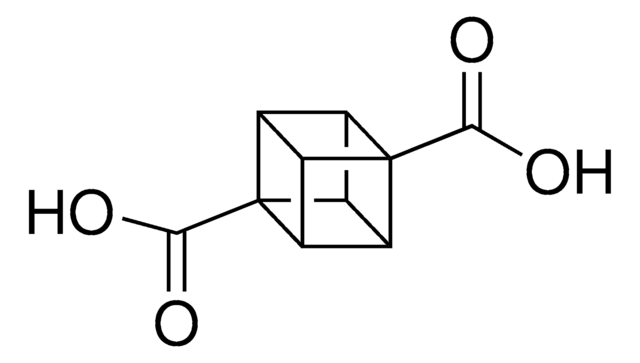Alle Fotos(1)
Wichtige Dokumente
288187
o-Carboran
98%
Synonym(e):
1,2-Dicarbadodecaboran(12)
Anmeldenzur Ansicht organisationsspezifischer und vertraglich vereinbarter Preise
Alle Fotos(1)
About This Item
Empirische Formel (Hill-System):
C2H12B10
CAS-Nummer:
Molekulargewicht:
144.23
EG-Nummer:
MDL-Nummer:
UNSPSC-Code:
12352300
PubChem Substanz-ID:
NACRES:
NA.23
Empfohlene Produkte
Assay
98%
mp (Schmelzpunkt)
260 °C (subl.) (lit.)
Lagertemp.
2-8°C
SMILES String
[bH]1[bH][bH][bH][bH][bH]cc[bH][bH][bH][bH]1
InChI
1S/C2H12B10/c1-2-4-6-8-10-12-11-9-7-5-3-1/h1-12H/b2-1-
InChIKey
PWHTZDUTEHXWHV-UPHRSURJSA-N
Verwandte Kategorien
Allgemeine Beschreibung
Electron deficient boron cage compounds with one or more carbon atoms as a ligand in the borane framework. The three common isomers are o-carborane, m-carborane and p-carborane 1The structure could be polyhedral or open cage.
Verpackung
Packaged in glass bottles
Signalwort
Warning
H-Sätze
Gefahreneinstufungen
Acute Tox. 4 Dermal - Acute Tox. 4 Inhalation - Acute Tox. 4 Oral
Lagerklassenschlüssel
11 - Combustible Solids
WGK
WGK 3
Flammpunkt (°F)
Not applicable
Flammpunkt (°C)
Not applicable
Persönliche Schutzausrüstung
dust mask type N95 (US), Eyeshields, Gloves
Hier finden Sie alle aktuellen Versionen:
Besitzen Sie dieses Produkt bereits?
In der Dokumentenbibliothek finden Sie die Dokumentation zu den Produkten, die Sie kürzlich erworben haben.
Yin-Ping Wang et al.
Chemistry (Weinheim an der Bergstrasse, Germany), 23(8), 1814-1819 (2016-11-30)
Palladium(II)-induced selective B(4)-H activation of an o-carboranylthioamide has been developed. A tetranuclear palladium(II) complex has been obtained in high yield with excellent regioselectivity. DFT calculations have confirmed that the B(4)-borometalate is lower in energy than the corresponding B(3)-borometalate. The product
Temidayo O B Olusanya et al.
Biophysical chemistry, 247, 25-33 (2019-02-24)
Based on the promise of liposomes as convenient vehicles for the transport of boronated agents for the boron neutron capture therapy (BCNT) of cancer, this paper reports a method for the formulation and characterisation of stable o-carborane-loaded liposomes (ca. 80-100 nm)
Issei Takeuchi et al.
Colloids and surfaces. B, Biointerfaces, 159, 360-365 (2017-08-15)
Poly(DL-lactide-co-glycolide) (PLGA) has been widely used and studied because of its biocompatibility and biodegradability. Recently, the usefulness of nanoparticles using poly(L-lactide-co-glycolide) (PLLGA) having a higher glass transition temperature than PLGA was suggested. In this study, we investigated the availability of
Unser Team von Wissenschaftlern verfügt über Erfahrung in allen Forschungsbereichen einschließlich Life Science, Materialwissenschaften, chemischer Synthese, Chromatographie, Analytik und vielen mehr..
Setzen Sie sich mit dem technischen Dienst in Verbindung.
